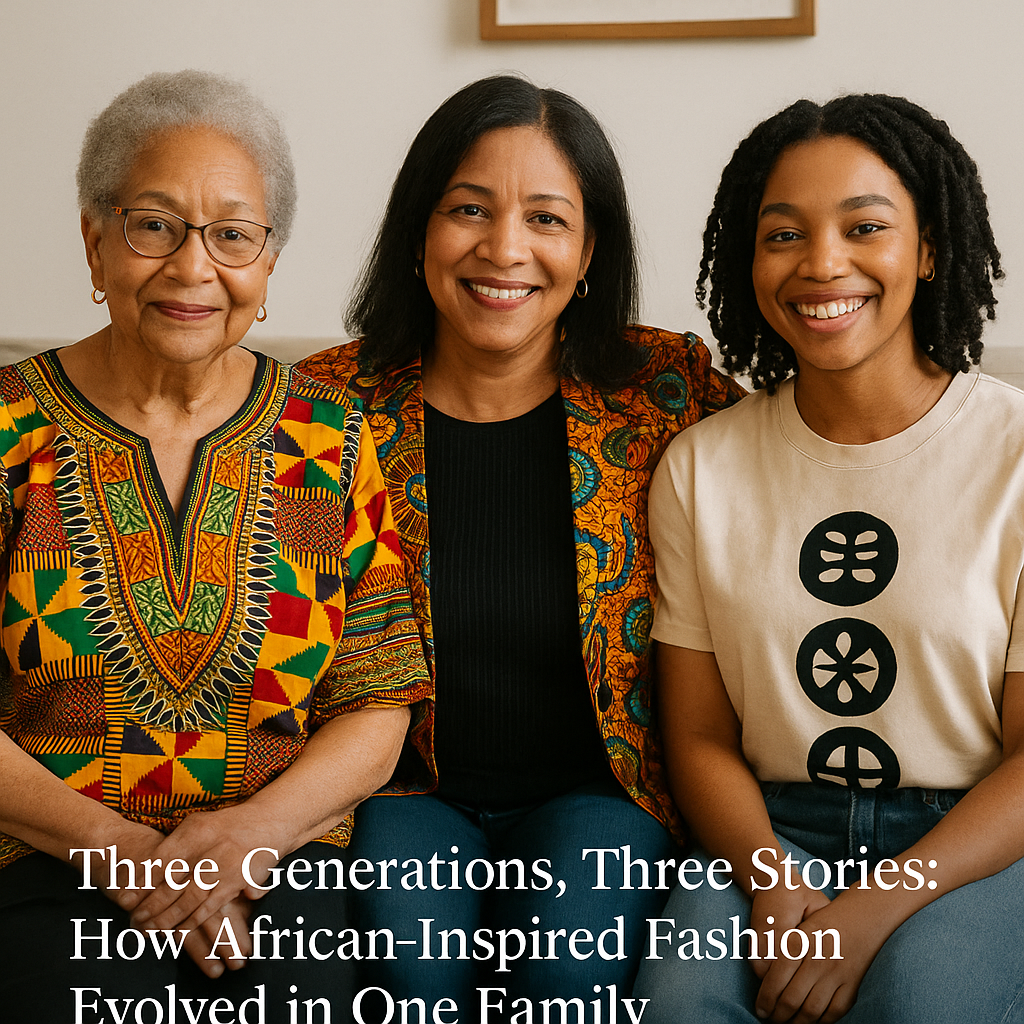
Three Stories: How African-Inspired Fashion Evolved in One Family
Share
Three Generations, Three Stories: How African-Inspired Fashion Evolved in One Family
In our "Threads Across Time" series, we examine how fashion has evolved across generations. Today, we sit down with the Johnson family – grandmother Dorothy (78), mother Patricia (52), and daughter Zara (24) – to hear their unique perspectives on wearing African-inspired clothing through different eras of American history.
Dorothy Johnson, 78: "We Had to Choose Between Fitting In and Standing Proud"
Dorothy smooths her vibrant kente-print blouse as she settles into her favorite armchair. Today, she wears her African-inspired clothing with ease, but it wasn't always this way.
"In 1967, when I was 20, I bought my first dashiki from a little shop in Harlem," Dorothy recalls, her eyes lighting up with memory. "It was the most beautiful thing I'd ever owned – deep blue with gold embroidery. But I could only wear it on weekends, and only in certain neighborhoods."
The Reality of the 1960s: Dorothy worked as a secretary at a law firm in Manhattan, where strict dress codes meant conservative suits and straightened hair. "One Monday, I forgot to take off my wooden bangles before work. My supervisor pulled me aside and said they looked 'unprofessional and distracting.' I never made that mistake again."
The weight of representation was constant. "We knew that if we wore our culture too boldly, white people would see us as militants or troublemakers. But if we assimilated completely, our own community would question our pride. It was exhausting."
Fashion as Silent Rebellion: Dorothy found small ways to honor her heritage: "I'd wear African-inspired earrings that I could take off quickly, or carry a small kente-cloth purse. My natural hair stayed hidden under wigs at work, but at home and in Harlem, I let my afro breathe."
The risks were real. Dorothy lost a promotion opportunity in 1971 when she attended a company picnic wearing a colorful headwrap. "They said I didn't fit the company image.' I knew exactly what they meant."
Patricia Johnson, 52: "We Were the Bridge Generation"
Patricia, Dorothy's daughter, experienced the 1980s and 90s differently – but the challenges weren't over.
"By the time I started my career in banking in 1995, things had changed, but not completely," Patricia explains, adjusting her elegant Ankara-print blazer. "I could wear some African-inspired jewelry and natural hairstyles, but there were still unspoken rules."
Navigating Professional Spaces: Patricia developed what she calls "strategic styling" – incorporating African elements in ways that felt authentic without triggering workplace discrimination. "I'd wear a conservative suit with African-print scarves, or natural hair styled in ways that looked 'polished' by corporate standards."
The 1990s brought new complexities. "Afrocentrism was becoming more mainstream, but there was still this idea that you had to 'tone it down' for professional success. I remember spending so much mental energy figuring out what was 'too much.'"
Teaching Cultural Pride: Despite workplace constraints, Patricia was determined to raise Zara with cultural confidence. "I made sure she saw me wearing beautiful African prints at home, at church, at family gatherings. I wanted her to know that our heritage was something to celebrate, not hide."
Patricia bought Zara her first African-inspired outfit when she was five – a tiny kente dress for a family wedding. "I wanted to give her what I couldn't always have: the freedom to wear her culture without fear."
The Shift in the 2000s: "By the time Zara was in high school, I noticed things changing. Her generation was posting pictures of their natural hair online, wearing African prints to prom, mixing traditional patterns with contemporary styles. It was beautiful to watch."
Zara Johnson, 24: "Cultural Fashion is My Birthright"
Zara embodies the confidence her grandmother and mother fought to make possible. She wears a LoudThread T-shirt featuring bold Adinkra symbols, paired with vintage jeans and natural curls styled in a twist-out.
"I wear African-inspired clothing because it makes me feel connected to my roots and confident in my identity," Zara says. "It's not a political statement for me the way it was for Grandma Dorothy – it's just who I am."
A Different World: At 24, Zara works in tech marketing, where diversity and inclusion initiatives actively celebrate cultural expression. "My manager complimented my Ankara blazer last week and asked where I got it. Can you imagine that conversation happening in Grandma's workplace?"
Zara's relationship with cultural fashion is complex in new ways. "I have privileges my grandmother couldn't dream of, but I also have new challenges. Like making sure I'm supporting African designers instead of fast-fashion companies that steal their patterns."
Social Media and Representation: "Instagram and TikTok changed everything," Zara explains. "I can see young Black women all over the world wearing their culture proudly. It's normalized African-inspired fashion in a way that previous generations didn't have."
But she's aware of the platform this gives her. "When I post photos in my cultural clothing, I think about the young girls who might see them. I want them to know it's beautiful and normal to express their heritage."
The Conversation: Three Perspectives, One Legacy
When we bring all three women together, the generational differences become both striking and beautiful.
On Professional Acceptance:
Dorothy: "You girls have no idea what it was like. I hid so much of myself just to keep my job."
Zara: "And because you hid it then, I don't have to hide it now."
Patricia: "I was caught in between – having more freedom than Mama but still having to be careful. I'm so glad you don't have to calculate every outfit the way we did."
On Cultural Authenticity:
Patricia: "Sometimes I worry that cultural fashion has become too commercialized. Are young people understanding the meaning behind the patterns?"
Zara: "I think we're more educated than you might think. I research the symbols on my clothes, I try to buy from Black-owned businesses, and I'm learning about different African cultures. It's not just aesthetics for us."
Dorothy: "The fact that she even has access to that education is progress. We had to learn everything through whispers and word-of-mouth."
On Responsibility and Freedom:
Dorothy: "Every time I see Zara walk confidently into any space wearing her culture, I think about the price we paid for that freedom."
Zara: "I don't take it for granted, Grandma. When I wear my LoudThread pieces to work or out with friends, I think about you. I'm living the dreams you couldn't."
Patricia: "We're all part of the same story – just different chapters."
What We Learn From the Johnsons
The Johnson family's story illustrates how far we've come and how each generation built upon the previous one's struggles and successes.
Generational Evolution:
- Dorothy's generation: Survival and strategic hiding
- Patricia's generation: Cautious integration and bridge-building
- Zara's generation: Confident expression and conscious choices
Common Threads: Despite different contexts, all three women share:
- Deep pride in African heritage
- Understanding that fashion is more than aesthetics
- Commitment to cultural preservation and transmission
- Recognition that their choices impact others
The Continuing Story
As our conversation winds down, Dorothy has the final word: "When I bought that first dashiki in 1967, I never imagined my granddaughter would be able to wear African-inspired clothing to her corporate job without thinking twice. But I dreamed it might be possible someday."
Patricia adds, "We're not done yet. Zara's generation will face new challenges we can't even imagine. But they'll handle them the same way we did – with pride, creativity, and determination."
Zara nods thoughtfully, "I want my future daughter to grow up in a world where cultural fashion isn't even a conversation – where it's just completely normal to wear your heritage. We're getting there."
The three women sit together, each wearing their African-inspired clothing in a unique yet equally proud manner – a living testament to how far cultural expression has evolved and how much courage it took to get here.
Their threads tell different stories, but they're all part of the same beautiful tapestry.
What's Your Family's Fashion Story?
Every family has their own journey with cultural expression and fashion. We'd love to hear yours. Share your intergenerational fashion stories with us at info@loudthread.com. Whether it's a grandmother's hidden headwrap, a parent's first dashiki, or your own journey to cultural pride – these stories matter.
Next in our "Threads Across Time" series: "From Workplace Discrimination to Corporate Celebration: How Professional Dress Codes Evolved." Don't miss it!
